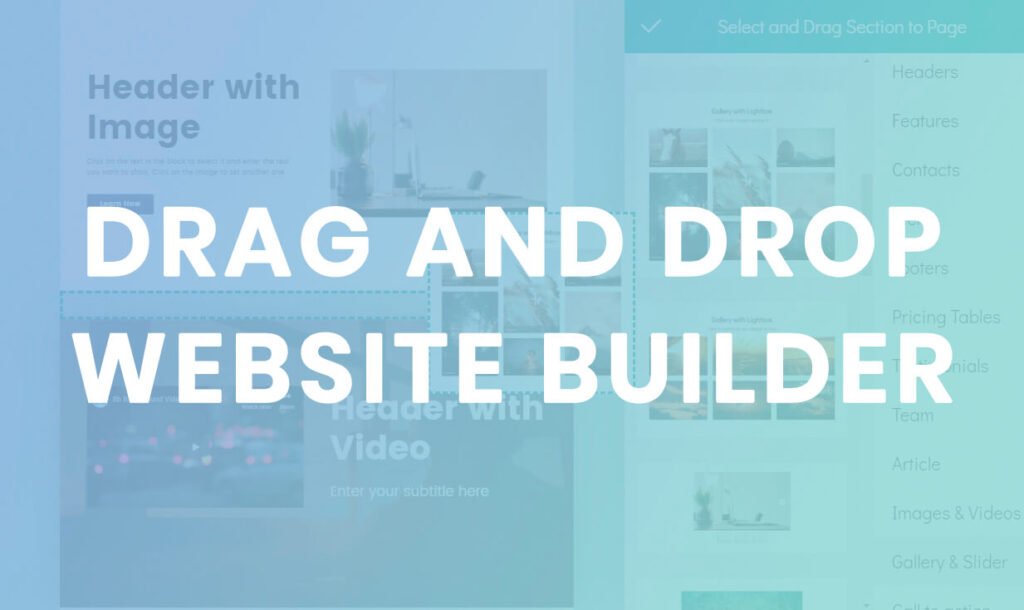Creating a stunning and functional website has never been easier, thanks to drag-and-drop website builders. These platforms empower users to design professional websites without the need for coding knowledge. Whether you’re a small business owner, freelancer, or someone looking to build an online presence, drag-and-drop tools can help you launch your site in no time.
In this comprehensive guide, we’ll explore what drag-and-drop website builders are, how they work, the pros and cons of using them, and the best platforms available in 2024. By the end, you’ll have a solid understanding of which tool is right for your needs, optimized with the best EEAT SEO practices.
What Are Drag-and-Drop Website Builders?
Drag-and-drop website builders are visual development platforms that allow you to create websites by simply dragging and dropping elements (like text, images, and buttons) onto a canvas. These platforms come with pre-designed templates, customization options, and intuitive interfaces, making website creation accessible to everyone, regardless of technical expertise.
Key Features of Drag-and-Drop Builders:
- Visual Editing: Design your site in real-time, seeing exactly how it will look to visitors.
- Pre-Made Templates: Choose from a variety of templates suited for different industries.
- Responsive Design: Automatically adjust your site for mobile, tablet, and desktop screens.
- SEO Tools: Built-in tools to optimize your website for search engines.
- E-commerce Support: Add online store features, payment gateways, and product pages with ease.
Pros of Using Drag-and-Drop Platforms
- User-Friendly Interface
- No coding skills are required; perfect for beginners.
- Drag, drop, and customize elements with ease.
- Fast Setup
- Launch your website in hours instead of weeks.
- Pre-built templates speed up the design process.
- Cost-Effective
- Affordable subscription plans compared to hiring a web developer.
- Free trials and budget-friendly options are available.
- Responsive and Mobile-Friendly
- Automatically optimized for mobile devices.
- Ensures a seamless experience across all screen sizes.
- SEO and Marketing Tools
- Built-in SEO features like meta tags, alt text, and XML sitemaps.
- Integrate with analytics tools to track visitor behavior.
- E-commerce Capabilities
- Easily set up an online store with shopping carts, checkout, and inventory management.
- Supports various payment gateways like PayPal and Stripe.
Cons of Drag-and-Drop Website Builders
- Limited Customization
- Templates can be restrictive, with limited design flexibility.
- Advanced features may require custom code (if supported).
- Scalability Issues
- Not ideal for large, complex websites with heavy traffic.
- May face challenges in integrating advanced functionalities.
- SEO Limitations
- While these platforms offer basic SEO tools, they may lack advanced options.
- Page speed can be slower compared to custom-coded websites, affecting rankings.
- Platform Dependency
- Your website is tied to the platform’s infrastructure, making migrations difficult.
- Switching platforms can result in losing your design and content.
Top Drag-and-Drop Website Builders in 2024
Here’s a curated list of the best drag-and-drop platforms to consider this year:
1. Webflow
- Best For: Designers and developers looking for more control.
- Pros: Highly customizable, advanced SEO tools, responsive design, powerful CMS.
- Cons: Steeper learning curve for beginners.
2. Wix
- Best For: Small businesses and beginners.
- Pros: Easy-to-use interface, large template library, built-in SEO Wiz tool.
- Cons: Limited customization for experienced developers.
3. Squarespace
- Best For: Creative professionals like photographers, artists, and bloggers.
- Pros: Beautiful, design-focused templates, integrated e-commerce features, strong branding tools.
- Cons: Less flexible customization, fewer third-party integrations.
4. Shopify
- Best For: E-commerce websites and online stores.
- Pros: Robust e-commerce features, numerous payment options, easy product management.
- Cons: Monthly fees can be higher, limited control over design elements.
5. Elementor (for WordPress)
- Best For: WordPress users looking for drag-and-drop functionality.
- Pros: Full control over design, extensive plugin support, SEO-friendly.
- Cons: Can slow down website speed if not optimized.
How to Optimize Drag-and-Drop Websites for EEAT SEO
Experience, Expertise, Authoritativeness, and Trustworthiness (EEAT) are key factors that search engines consider for ranking your website. Here’s how to optimize your drag-and-drop site:
- Experience
- Showcase case studies, client testimonials, and portfolio examples.
- Add a blog section to share insights and updates regularly.
- Expertise
- Write in-depth guides and tutorials relevant to your industry.
- Use structured data markup (schema) to highlight your expertise in search results.
- Authoritativeness
- Build backlinks from reputable websites in your niche.
- Get featured in industry publications and guest blogs.
- Trustworthiness
- Use HTTPS to secure your website.
- Include clear contact information, privacy policy, and terms of service.
- Display trust signals like certifications, awards, and user reviews.
Pro Tip: Regularly update your content to stay relevant and maintain a strong SEO presence. Utilize tools like Google Analytics and Google Search Console to monitor performance and optimize further.
Best Practices for Building a Drag-and-Drop Website
- Choose a Template that Matches Your Brand
- Opt for a clean, professional design that aligns with your brand identity.
- Optimize for Speed
- Compress images, use lazy loading, and avoid heavy animations to enhance site performance.
- Focus on User Experience (UX)
- Ensure intuitive navigation, fast loading times, and mobile responsiveness.
- Utilize clear calls-to-action (CTAs) to guide visitors through your site.
- Leverage SEO Tools
- Optimize meta titles, descriptions, headings, and image alt texts.
- Use tools like Yoast SEO (if using WordPress) or Webflow’s SEO panel.
- Incorporate Analytics and Tracking
- Set up Google Analytics and tracking pixels to measure traffic and user behavior.
- Use A/B testing to refine your website’s design and content strategy.
Conclusion
Drag-and-drop website builders are a fantastic option for anyone looking to create a website quickly and affordably. While they have some limitations, they offer a range of features that make website building accessible to non-technical users. Whether you’re a small business owner, a freelancer, or just someone with a creative idea, there’s a platform out there that fits your needs.
By leveraging the best practices in this guide and focusing on EEAT SEO optimization, you can build a professional, high-ranking website that attracts visitors and drives growth.


